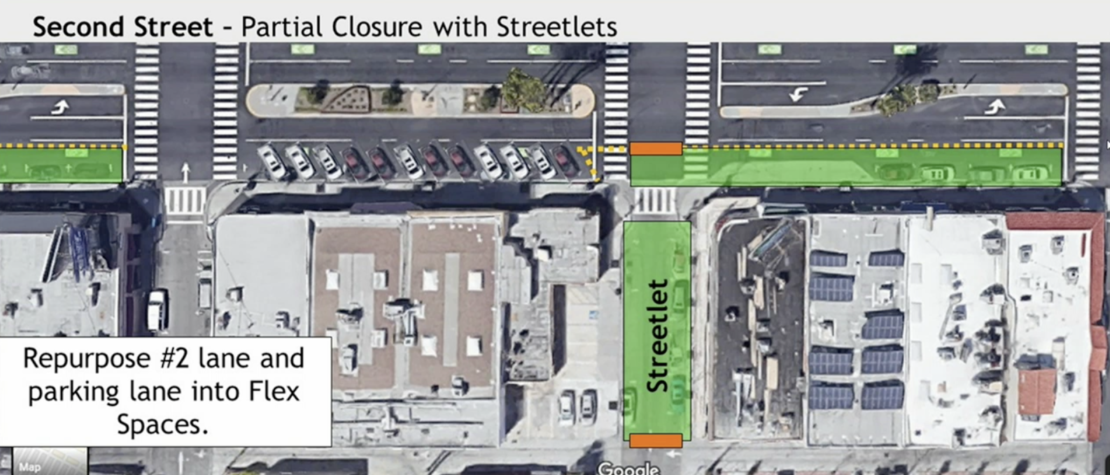Long Beach may soon allow restaurants and entertainment groups to use public streets, parking lots, sidewalks and other spaces as the city seeks ways to help businesses struggling financially in the wake of closures that began in mid-March.
The action Tuesday by the City Council, which unanimously endorsed a general framework for opening public spaces in new ways, comes with support of the Chamber of Commerce and a task force empowered by the mayor, which released a detailed list of actions that could help businesses survive the coronavirus pandemic.
Restaurants can now only offer take-out, and retail businesses can sell goods via curbside pickup. When health orders are further relaxed in coming weeks and months, the city would like to embrace more parklets—which are dining areas that extend out to sidewalks—along with full street closures similar to what it already does with its Beach Streets events, in which major thoroughfares are shut down for a few hours for non-vehicular traffic.
Some areas of the city may have partial closures or flex zones, where one side of the street is closed entirely to vehicular traffic while the other remains open. These areas provide temporary infrastructure similar to a parklet, but in a lighter, quicker, more cost-effective manner.
Santa Fe Avenue on the westside between Pacific Coast Highway and Wardlow Avenue was mentioned as fitting this description, along with Second Street in Belmont Shore.

Some streets may have full closures. Areas that have already seen these types of closures—think Pine Avenue between First and Third Streets for previous events like New Year’s Eve—would be candidates for this.
“As we move forward, we fully support flexibility,” Public Works Director Craig Beck told the council. “The hope is to be able to move quickly, efficiently, and with low-cost overhead.”
Carl Hickman, a traffic engineer for the city, noted that bike boulevards—such as the Daisy-Myrtle bike boulevard corridor—and denser neighborhoods with limited green space access would be key areas to practice the more bold open streets projects. And while each situation presents a unique opportunity, larger issues around safety and accessibility loom.
The city would need equipment to make all this happen, such as water barriers, cones, signage—all of which would have to be used strategically if not supplemented through other means, Hickman said.
“Our public works team does not have everything needed to fulfill these requests,” he said.
ADA requirements, public safety, and emergency access are additional factors to consider—along with concerns of residents. Fourth District Councilman Daryl Supernaw noted that most outdoor dining spaces near residences—a direct reflection of his own district that includes the Traffic Circle—would typically undergo a lengthy Conditional Use Permit process.
“How would ‘speeding this process up’ affect the overall outcome?” Supernaw asked. “If we’re fast-tracking this, we want to know: What are the neighbors’ rights? Or would there be something at least similar to a CUP process where neighbors could weigh in on this?”
This wasn’t the only concern: Councilwoman Stacy Mungo, who represents East Long Beach, reiterated that neighborhoods must have a say in the process; Councilman Roberto Uranga, who represents parts of the westide and Bixby Knolls, expressed concern over late-night establishments and noise issues.
Mayor Robert Garcia emphasized that these changes were not solely about improving businesses but increasing residents’ quality of life. Cities such as Seattle, which will permanently close nearly 20 miles of streets to vehicular traffic by the end of this month, have accomplished this with great success, he said.
Garcia noted that opening up streets moves beyond outdoor dining options. They can provide many things, from recreational space that respect social distancing to concepts such as converting parking lots into drive-in movie theaters.
One way to help restaurants in the future? Go alfresco by opening roads and lots to diners
“I want us to move quickly on this,” Garcia said. “We certainly don’t want to create open streets projects in parts of the city where it won’t work. This is not a mandate to do it everywhere.”
To pay for part of the project, the city could shift funding from its Beach Streets initiative, which comes through LA Metro.
Staff is expected to return formal suggestions in the coming weeks.
Meanwhile, a task force led by former Mayor Bob Foster offered this week other concrete measures the city could take to help businesses, including use of outdoor spaces.
The task force also recommended:
- Streamlining city permitting, allowing businesses to obtain permits in days, not months.
- Coordinating with state agencies such as the Alcohol Beverage Control Board, to allow drinks to be served outside.
- Pre-approving applications for outdoor activities, so that when the state and county relax health orders, businesses can move forward quickly.
- Reducing costs and fees, including possibly waiving fees required to obtain permits.
- Creating small business loans to help vendors with one-time overhead costs to change their business model.

